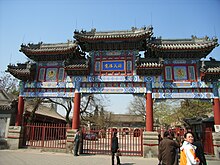White Cloud Temple
| White Cloud Temple | |
|---|---|

The archway in front of the entrance to the temple site
|
|
| Basic information | |
| Location | Beijing, China |
| Geographic coordinates | 39°53′56″N 116°20′17″E / 39.8989°N 116.338°ECoordinates: 39°53′56″N 116°20′17″E / 39.8989°N 116.338°E |
| Affiliation | Daoist |
| Completed | 14th Century Ming Dynasty |
The White Cloud Temple or the Monastery of the White Clouds (simplified Chinese: ; traditional Chinese: ; pinyin: ; literally: "White Cloud Compound") is a Daoist temple located in Beijing, China. It is one of "The Three Great Ancestral Courts" of the Complete Perfection School of Taoism, and is titled "The First Temple under Heaven".
The White Cloud Temple was first founded in the mid-8th century during the Tang dynasty, and was initially called Tianchang Abbey (天長觀; Abbey of Celestial Perpetuity). During this period, the abbey was state-sponsored and staffed by an elite clergy. From 1125 to 1215 when what is now Beijing was controlled by the Jin dynasty, the abbey served as the Daoist administrative headquarters and played an important role in state ceremonies. After Beijing was taken by the Mongols in 1215, the abbey was taken over by the Quanzhen patriarch Qiu Chuji, and became the headquarters of the Quanzhen movement until the establishment of the Ming dynasty. Qiu renamed the abbey Changchun Gong (長春宮; Palace of Eternal Spring). In October 1222, Qiu gave his exposition of Daoism to Genghis Khan after a three-year trek from Shandong Province after being summoned. Qiu's successor, Yin Zhiping (尹志平; 1169-1251) built a memorial shrine over Qiu's grave. This shrine became a temple in its own right called White Cloud Temple. The abbey was damaged when the Mongols took over in the late 13th century, and during the Ming dynasty the Changchun Gong disappeared. However, White Cloud Temple survived and took over the functions of Changchun Gong. During the Ming dynasty, monks from the Zhengyi school took over operations of the abbey, but continued Quanzhen traditions and ordination ceremonies. Zhengyi control over the temple continued until the 17th century, when their monopoly ended and the Quanzhen master Wang Changyue (王常月; ?-1680) took over. To this day, White Cloud Temple remains Quanzhen controlled. During the 20th century, the abbey was without an abbot for the 1940s, and was closed when the Communists came to power in 1949. Unlike many other historical sites which were damaged during the Cultural Revolution, White Cloud Temple was well-protected and remained safe. Today it is again a fully functioning temple and is the seat of the Chinese Daoist Association.
...
Wikipedia
